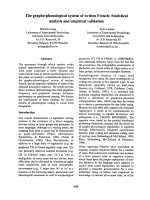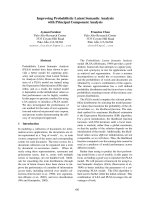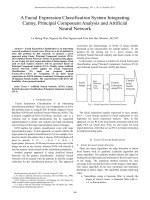a facial expression classification system integrating canny, principal component analysis and artificial neural network
Bạn đang xem bản rút gọn của tài liệu. Xem và tải ngay bản đầy đủ của tài liệu tại đây (525.43 KB, 6 trang )
Abstract— Facial Expression Classification is an interesting
research problem in recent years. There are a lot of methods to
solve this problem. In this research, we propose a novel
approach using Canny, Principal Component Analysis (PCA)
and Artificial Neural Network. Firstly, in preprocessing phase,
we use Canny for local region detection of facial images. Then
each of local region’s features will be presented based on
Principal Component Analysis (PCA). Finally, using Artificial
Neural Network (ANN) applies for Facial Expression
Classification. We apply our proposal method
(Canny_PCA_ANN) for recognition of six basic facial
expressions on JAFFE database consisting 213 images posed by
10 Japanese female models. The experimental result shows the
feasibility of our proposal method.
Index Terms— Artificial Neural Network (ANN), Canny,
Facial Expression Classification, Principal Component Analysis
(PCA).
I. INTRODUCTION
Facial Expression Classification is an interesting
classification problem. There are a lot of approaches to solve
this problem such as: using K-NN, K-Mean, Support Vector
Machine (SVM) and Artificial Neural Network (ANN). The
k-nearest neighbor (k-NN) or K-Mean decision rule is a
common tool in image classification but its sequential
implementation is slowly and requires the high calculating
costs because of the large representation space of images.
SVM applies for pattern classification even with large
representation space. In this approach, we need to define the
hyper-plane for pattern classification [13]. For example, if we
need to classify the pattern into L classes, SVM methods will
need to specify 1+ 2+ … + (L-1) = L (L-1) / 2
hyper-plane. However, SVM may be errors in the case of the
image are not in any classes, because SVM will classify it into
the nearest classes based on the calculation parameters.
Another popular approach is using Artificial Neural
Network for the pattern classification. Artificial Neural
Network will be trained with the patterns to find the weight
collection for the classification process [1]. This approach
overcomes the disadvantage of SVM of using suitable
threshold in the classification for outside pattern. If the
Manuscript received April 9, 2011.
L.H. Thai is with the University of Science, Ho Chi Minh city, 7000,
Vietnam (email: ).
N.D.T.Nguyen is with the University of Pedagogy, Ho Chi Minh city,
7000, Vietnam (email: ).
T. S. Hai is with the University of Pedagogy, Ho Chi Minh city, 7000,
Vietnam (email: ).
patterns do not belong any in L given classes, the
Artificial Neural Network identify and report results to the
outside given classes.
In this paper, we propose a solution for Facial Expression
Classification using Principal Component Analysis (PCA)
and Artificial Neural Network (ANN) like below:
Fig. 1. Facial Expression Classification Process
The facial expression usually expressed in eyes, mouth,
brow… Local feature analysis in facial expression is very
important for facial expression analysis. Thus, in this
approach, we use PCA for local feature extraction and do not
apply PCA for whole face. First, we use Canny for local
region detection. After that we use PCA to feature extraction
in small presenting space.
II. FACIAL FEATURE EXTRACTION
A. Canny for local region detection
There are many algorithms for edge detection to detect
local feature such as: gradient, Laplacian algorithm and canny
algorithm. The gradient method detects the edges by looking
for the maximum and minimum in the first derivative of the
image. The Laplacian method searches for zero crossings in
the second derivative of the image to find edges. The canny
algorithm [9,12] uses maximum and minimum threshold to
detect edges. The algorithm include following steps:
Smoothing: using a Gaussian filter to smooth the
image to remove noise. A Gaussian filter with σ= 1.4
is shown below:
A Facial Expression Classification System Integrating
Canny, Principal Component Analysis and Artificial
Neural Network
Le Hoang Thai, Nguyen Do Thai Nguyen and Tran Son Hai, Member of IACSIT
Classify
using
Neural
Network
Facial
Image
Edge
Detection
using
Canny
Feature
Extraction
using PCA
2 4 5 4 2
4 9 12 9 4
1
5 12 15 12 5
159
4 9 12 9 4
2 4 5 4 2
B
(1)
Identifying gradients: First, approximating the
gradient in the x- and y-directions by applying the
Sobel-operator shown below:
1 0 1
2 0 2
1 0 1
x
H
1 2 1
000
1 2 1
y
H
(2)
Then, applying the law of Pythagoras computes the edge
strengths:
22
xy
G G G
xy
G G G
(3)
Where G
x
is the gradient in the x-direction and G
y
is the
gradient in the y-direction.
The direction of the edges:
||
arctan
||
y
x
G
G
(4)
Edge tracking: All local maxima in the gradient image
marked as edges, then using double threshold to
determine strong edges and weak edges. Remove all
edges that are not connected to a strong edge.
In this research, we used Canny algorithm [9,12] to detect
local regions for the facial expression features – left and right
eyebrows, left and right eyes, and mouth. First, we crop the
original image (256x256) into cropped image (85x85) only
contain face. After applying histogram equalization, we use
canny algorithm for local region detection. Figure 2 shows
Facial Feature Extraction Process. Figure 3 shows a sample
image, and figure 4 shows the local region detection for the
facial features. Figure 5 shows results detected by edge
detection using canny algorithm.
Fig. 3. An Facial Image in JAFEE
Fig. 2. Facial Feature Extraction Process
Fig. 4. The local region detection for the facial features
Original Image
(256 × 256)
Cropped
(85x85)
Histogram
Equalization
Using Canny algorithm to region
detection
Using PCA to local features
extraction presentation
Fig. 5. Results detected by edge detection using canny algorithm
B. Principal Component Analysis for Facial Feature
Extraction
After detected local feature, we used PCA to extract
features for left and right eyebrows, left and right eyes, and
mouth. These are the vector v
1
, v
2
, v
3
, v
4
and v
5
. Eigenvector
is combination of five vectors:
V= {v
1
, v
2
, v
3
, v
4
, v
5
}
(5)
PCA is a procedure that reduces the dimensionality of the
data while retaining as much as possible of the variation
present in the original dataset. PCA use a linear
transformation that converts data from a high dimensional
space (x) to a lower dimensional space (y):
1
2
n
x
x
x
x
1
2
k
y
y
y
y
Fig. 6. Decreasing representation space.
y Tx
1 11 1 12 2 1
nn
y t x t x t x
2 21 1 22 2 2
nn
y t x t x t x
…
1 1 2 2
k k k kn n
y t x t x t x
11 12 1
21 22 2
12
n
n
k k kn
t t t
t t t
T
t t t
(6)
Let X={x
1
,x
2
,…x
m
} are set of Nx1 vectors. The method
runs in six steps:
Computing mean of sets x:
1
1
M
i
i
xx
M
(7)
Subtract the mean:
ii
xx
(8)
Set the matrix
12
m
A
, then
compute:
1
1
M
TT
ii
i
C AA
M
(9)
Computing the eigenvalues of C:
12
n
Computing the eigenvectors of C: u
1
, u
2
, …, u
n
1 1 2 2
1
N
n n i i
i
x x y u y u y u y u
(10)
Dimensionality reduction
1
K
ii
i
x x y u
(11)
Where K<<N, u
i
are K largest eigenvalues. The
representation of
xx
into the basis u
1
, u
2
, … , u
k
is
1
2
k
y
y
y
III. FACIAL EXPRESSION CLASSIFICATION USING
ARTIFICIAL NEURAL NETWORK
In this paper, we use Multi Layer Perceptron (MLP) Neural
Network with back propagation learning algorithm.
A. Multi layer Perceptron (MLP) Neural Network
Input layer Hidden layer Output layer
x
1
x
2
x
n
y
1
y
1
y
m
Fig. 7. Multi Layer Perceptron structure
Decrease
Dimensional
space
A Multi Layer Perceptron (MLP) is a function
m21n21
y
ˆ
, ,y
ˆ
,y
ˆ
y
ˆ
and x, ,x,xx with ,W,xMLPy
ˆ
W is the set of parameters
L,j,i,w,w
L
0i
L
ij
For each unit i of layer L of the MLP. Integration:
j
L
0i
L
ij
1L
j
wwys
(12)
Transfer:
L
j
y
= f(s), where
t
e
1
1
tf
(13)
On the input layer (L = 0):
j
L
j
xy
On the output layer (L = L):
j
L
j
y
ˆ
y
The MLP uses the algorithm of Gradient Back-Propagation
for training to update W.
B. Structure of MLP Neural Network
MLP Neural Network applies for seven basic facial
expression analysis signed MLP_FEA. MLP_FEA has 7
output nodes corresponding to anger, fear, surprise, sad,
happy, disgust and neutral. The first output node give the
probability assessment belong anger.
MLP_FEA has 200 input nodes corresponding to the total
dimension of five feature vectors in V set.
The number of hidden nodes and learning rate
will be
identified based on experimental result.
Fig. 8. Structure of MLP Neural Network
TABLE I. OUTPUT NODE CORRESPONDING TO ANGER, FEAR,
SURPRISE, SAD, HAPPY, DISGUST AND NEUTRAL
Feeling
Max
Anger
Y1
Fear
Y2
Surprise
Y3
Sad
Y4
Happy
Y5
Disgust
Y6
Neutral
Y7
IV. EXPERIMENTAL RESULT
We apply our proposal method for recognition of six basic
facial expressions on JAFEE database consisting 213 images
posed by 10 Japanese female models. We conduct the fast
training phase (with maximum 200000 epochs of training)
with the learning rate in {0.1, 0.2, 0.3, 0.4, 0.5, 0.6, 0.7, 0.8,
0.9} and the number of hidden nodes in {5, 10, 15, 20, 25} to
identify the optimal MLP_FEA configuration. The precision
of classification see the table below:
TABLE II. FAST TRAINING WITH 200000 EPOCHS
Hidden
Nodes
Learning rate
0.1
0.2
0.3
0.4
0.5
0.6
0.7
0.8
0.9
5
78.
57
74.
29
75.
71
71.
43
72.
86
75.
71
77.
14
71.
43
74.
29
10
80.
00
78.
57
84.
29
80.
00
81.
43
81.
43
80.
00
82.
86
78.
57
15
77.
14
75.
71
74.
29
80.
00
81.
43
82.
86
78.
57
75.
71
81.
43
20
78.
57
75.
71
78.
57
74.
29
75.
71
75.
71
82.
86
81.
43
80.
00
25
68.
57
71.
43
70.
00
71.
43
68.
57
70.
00
72.
86
71.
43
71.
43
It is easy to see that the best classification with = 0.3 and
the number of hidden nodes = 10. Therefore, we develop
ANN with 10 hidden nodes and = 0.3 to apply for
recognition of six basic facial expressions.
Fig 9. 3D chart of Fast Training with 200000 epochs
Fig 10. Fast Training with 200000 epochs
Based on the above optimal MLP_FEA configuration, we
conduct the training with error = 10
-7
and obtained the result
below:
TABLE III. FACIAL EXPRESSION CLASSIFICATION
Feeling
Correct
Classifications
Classification
Accuracy %
Anger
9/10
90
Fear
8/10
80
Surprise
9/10
90
Sadness
9/10
90
Joy
8/10
80
Disgust
9/10
90
Neutral
8/10
80
The average facial expression classification of our proposal
method (Canny_PCA_ANN) is 85.7%. We compare our
proposal methods with Rapid Facial Expression
Classification Using Artificial Neural Network [10], Facial
Expression Classification Using Multi Artificial Neural
Network [11] in the same JAFFE database.
TABLE IV. COMPARATION CLASSIFICATION RATE OF METHODS
Method
Classification
Accuracy %
Rapid Facial
Expression
Classification Using
Artificial Neural
Networks [10]
73.3%
Facial Expression
Classification Using
Multi Artificial Neural
Network [11]
83.0%
Proposal System
(Canny_PCA_ANN)
85.7%
This method (Canny_PCA_ANN) improved the
Classification Accuracy than Rapid Facial Expression
Classification Using Artificial Neural Networks [10] and
Facial Expression Classification Using Multi Artificial
Neural Network [11] (only used ANN).
Beside, this method does not need face boundary detection
process perfect correctly. We used Canny for search local
regional (left – right eyebrow, eyes and mouth) directly.
V. CONCLUSION
In this paper, we suggest a new method using Canny,
Principal Component Analysis (PCA) and Artificial Neural
Network (ANN) apply for facial expression classification.
Canny and PCA apply for local facial feature extraction. A
facial image is separated to five local regions (left eye, right
eye, left and right eyebrows and mouth). Each of those
regions’ features is presented by PCA. So that image
representation space is reduced.
Instead of using ANN based on the large image
representation space, ANN is used to classify Facial
Expression based on PCA representation. So the training time
of ANN is reduced.
To experience the feasibility of our approach, in this
research, we built recognition of six basic facial expressions
system on JAFFE database consisting 213 images posed by
10 Japanese female models. The experimental result shows
the feasibility of our proposal system.
However, this approach uses ANN for classifying and the
number of hidden nodes is identified by experience. It
required the high calculating cost for learning process.
VI. REFERENCES
[1] S. Tong, and E. Chang, ”Support vector machine active learning for
image retrieval”, in Proc. ninth ACM international conference on
Multimedia, New York, 2001, pp. 107-118.
[2] V. H. Nguyen, “Facial Feature Extraction Based on Wavelet
Transform”, Lecture Note in Computer Science, Springer: Press, 2009,
Vol 5855/2099, pp 30-339.
[3] M. J. Lyons,J. Budynek, S. Akamatsu, “Automatic Classification of
Single Facial Images”, IEEE Transactions on Pattern Analysis and
Machine Intelligence , 1999, Vol 21, pp1357-1362.
[4] Y. Cho and Z. Chi, “Genetic Evolution Processing of Data Structure
for Image Classification”, IEEE Transaction on Knowledge and Data
Engineering, 2005, Vol.17, No 2, pp 216-231.
[5] S. T. Li and A. K. Zan, Hand Book of Face Regconition, Springer:
Press, 2005.
[6] C. M. Bishop, Pattern Recognition and Machine Learning, Springer:
Press, 2006.
[7] I. Buciu and I. Pista, “Application of non-Negative and Local non
Negative Matrix Factorization to Facial Expression Recognition”, the
17th International Conference on Pattern Recognition , Patern
Recognition, 2004, Vol. 1, pp 288-291.
[8] P. Zhao-yi , Z. Yan-hui , Z. Yu, “Real-time Facial Expression
Recognition Based on Adaptive Canny Operator Edge Detection”, in
Proc. Second International Conference on MultiMedia and Information
Technology, 2010, Vol. 1, pp 154-157.
[9] F. Mai, Y. Hung, H. Zhong, and W. Sze, “A hierarchical approach for
fast and robust ellipse extraction”, IEEE International Conference on
Image Processing, 2007, Vol. 5, pp 345-349.
[10] Nathan Cantelmo (2007), “Rapid Facial Expression Classification
Using Artificial Neural Networks”, Northwestern University [online],
Available:
[11] L. H. Thai, T. S. Hai, “Facial Expression Classification Based on Multi
Artificial Neural Network”, in Proc. International conference on
Advance Computing and Applications, Vietnam, 2010, pp. 125-133
[12] J. Canny, “A computational approach to edge detection”, IEEE
Transactions on Pattern Analysis and Machine Intelligence, 1986,
Vol.PAMI-8, No 6, pp 679–698.
[13] S. Tong, E. Chang, “Support vector machine active learning for image
retrieval”, in Proc. 9th ACM international conference on Multimedia ,
New York, 2001, pp 107-118
Dr Le Hoang Thai received B.S degree and M.S degree in Computer
Science from Hanoi University of Technology, Vietnam, in 1995 and 1997.
He received Ph.D. degree in Computer Science from Ho Chi Minh
University of Sciences, Vietnam, in 2004. Since 1999, he has been a lecturer
at Faculty of Information Technology, Ho Chi Minh University of Natural
Sciences, Vietnam. His research interests include soft computing pattern
recognition, image processing, biometric and computer vision. Dr. Le Hoang
Thai is co-author over twenty five papers in international journals and
international conferences.
Nguyen Do Thai Nguyen received B.S degree from University of Pedagogy,
Ho Chi Minh city, Vietnam, in 2007. He is currently pursuing the M.S
degree in Computer Science Ho Chi Minh University of Science.
From 2008-2010, he has been a lecturer at Faculty of Mathematics and
Computer Science in University of Pedagogy, Ho Chi Minh city, Vietnam.
His research interests include soft computing pattern recognition, machine
learning and computer vision. Mr. Nguyen Do Thai Nguyen is co-author of
two papers in the international conferences.
Tran Son Hai is a member of IACSIT and received B.S degree and M.S
degree in Ho Chi Minh University of Natural Sciences, Vietnam in 2003 and
2007. From 2007-2010, he has been a lecturer at Faculty of Mathematics and
Computer Science in University of Pedagogy, Ho Chi Minh city, Vietnam.
Since 2010, he has been the dean of Information System department of
Informatics Technology Faculty and a member of Science committee of
Informatics Technology Faculty. His research interests include soft
computing pattern recognition, and computer vision. Mr. Tran Son Hai is
co-author of four papers in the international conferences and national
conferences.









